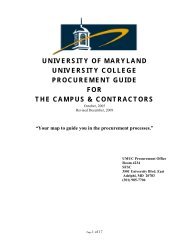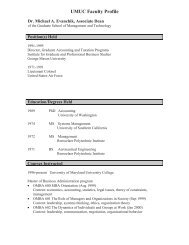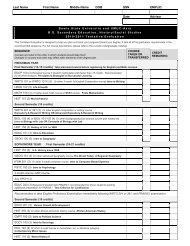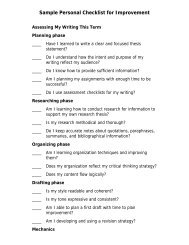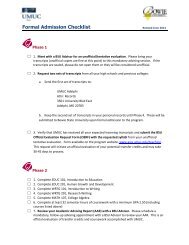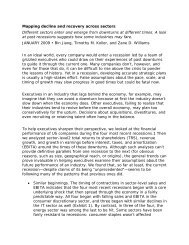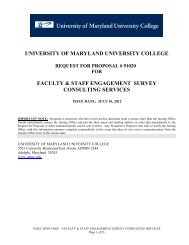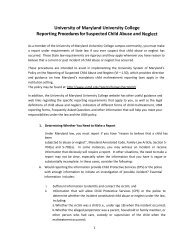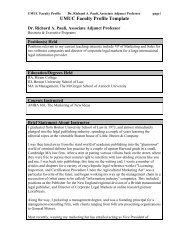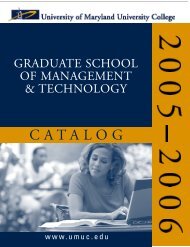A+B. Intro_SJ.1 - University of Maryland University College
A+B. Intro_SJ.1 - University of Maryland University College
A+B. Intro_SJ.1 - University of Maryland University College
Create successful ePaper yourself
Turn your PDF publications into a flip-book with our unique Google optimized e-Paper software.
Course Descriptions<br />
The Unit <strong>of</strong> Cre d i t<br />
The unit <strong>of</strong> credit is the semester hour. One semester hour is awarded on the basis<br />
<strong>of</strong> either <strong>of</strong> two sets <strong>of</strong> criteria, as fo l l ow s :<br />
• At least 15 hours (50 minutes each) <strong>of</strong> actual class meeting, or the equiva l e n t<br />
in guided learning activity (exc l u s i ve <strong>of</strong> registration and study days, holidays ,<br />
and final ex a m i n a t i o n s );<br />
• At least 30 hours (50 minutes each) <strong>of</strong> supervised laboratory or studio wo r k<br />
( exc l u s i ve <strong>of</strong> registration and study days, holidays, and final ex a m i n a t i o n s ).<br />
P re re q u i s i te s<br />
Prerequisites, normally stated in terms <strong>of</strong> numbered courses, represent the leve l<br />
<strong>of</strong> knowledge a student should have acquired before enrolling in a given course. It<br />
is each stu d e n t ’s personal responsibility to make certain he or she is academically<br />
prepared to ta ke a course. Fa c u l ty members are not expected to repeat material<br />
listed as being prerequisite.<br />
ACCT 608 Fraud Detection and Accounting Ethics (3)<br />
A critical competency for the 21st-century accountant is the ability<br />
to evaluate and analyze the various aspects <strong>of</strong> fraud pre ve n-<br />
tion and detection in a strategic context. Sp e c i f i c a l l y, the nature<br />
<strong>of</strong> fraud, elements <strong>of</strong> fraud, fraud pre vention, fraud detect i o n ,<br />
fraud investigation, use <strong>of</strong> controls to pre vent fraud, and methods<br />
<strong>of</strong> fraud resolution are examined in this course. An emphasis<br />
is placed on the employment <strong>of</strong> forensic accounting techniques<br />
to analyze what is behind the data being generated by the accounting<br />
system, to detect internal control weaknesses and to map out<br />
a fraud investigation program. The role <strong>of</strong> accounting ethics is<br />
e x p l o red throughout the course in detail and considered in the<br />
context <strong>of</strong> laws, regulations, and the organization’s culture.<br />
ACCT 609 E-Commerce Accounting (3)<br />
The objectives <strong>of</strong> the course are to assist the accounting student<br />
in gaining an understanding <strong>of</strong> the role he or she plays as an<br />
advisor to business in (1) identifying tax choices, payment methods,<br />
and strategic e-business alternatives; (2) managing Web<br />
security risks for clients; and (3) providing financial advice about<br />
the cost <strong>of</strong> these alternative e-business methods. Importantly,<br />
this course will help accounting students achieve a better understanding<br />
<strong>of</strong> how the Web culture is impacting accounting relationships<br />
and practices. Among the topics described in the course<br />
are e-business models, regulatory environment from privacy to<br />
taxation, security in online communications, digital certificates<br />
and digital signatures, financial analysis <strong>of</strong> IT investments, risk<br />
identification and assessment, Net mapping, and firewalls. The<br />
methods explained in the course are designed to help managers<br />
understand the online environment and acquire a knowledge<br />
base that will allow them to make more insightful decisions.<br />
E-commerce methods are changing so rapidly that it is important<br />
to use a number <strong>of</strong> online references for this course.<br />
| 110 | 2003–2004 Graduate Catalog




